Trichoptera
The Trichoptera is a diverse order of freshwater insects. The global species
total is not known but there are over 600 genera. Tropical Asia is disproportionately
rich in 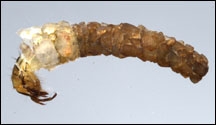 Trichoptera
compared to the rest of the world, and is estimated to support as many
as 50,000 species. Some genera (e.g., Chimarra: Philopotamidae)
may contain 500 Southeast Asian species! Trichoptera can be divided broadly
into species that are free-living, and may or may not live within a portable
case, and those that live within fixed shelters; most species in the second
group spin a net with which they filter the passing water for food. The
adults of all species are moth-like creatures with hair-covered wings;
a few (Macrostemum: Hydropsychidae) are brightly coloured but most
are dull and inconspicuous.
Trichoptera
compared to the rest of the world, and is estimated to support as many
as 50,000 species. Some genera (e.g., Chimarra: Philopotamidae)
may contain 500 Southeast Asian species! Trichoptera can be divided broadly
into species that are free-living, and may or may not live within a portable
case, and those that live within fixed shelters; most species in the second
group spin a net with which they filter the passing water for food. The
adults of all species are moth-like creatures with hair-covered wings;
a few (Macrostemum: Hydropsychidae) are brightly coloured but most
are dull and inconspicuous.
Because they are such a diverse group, Trichoptera occupy a range of freshwater
habitats; the majority are found in rivers although some case-building
species (mainly Leptoceridae) are confined to standing water. Feeding
habits are likewise varied. Filter-feeding by means of silk nets occurs
in the species-rich Philopotamidae and Hydropsychidae, but larvae of some
case-building families (e.g., Leptoceridae) sieve food particles from
the current with the aid of bristles on the legs. The architecture of
nets spun by filter-feeders varies among species: some use coarse mesh
with large pores, others produce fine mesh with minute pores. This results
in a difference among species in the types of food captured and eaten.
It also has the effect that some species live in faster currents than
others: fine-meshed nets function best in slow currents, whereas coarse-meshed
nets are effective in swift currents that transport relatively large particles.
The use of different foods and microhabitats contributes to a downstream
replacement (or longitudinal zonation) of species in some Trichoptera
and is seen in the Hydropsychidae, which are generally the most abundant
family of Trichoptera in Asian Rivers.
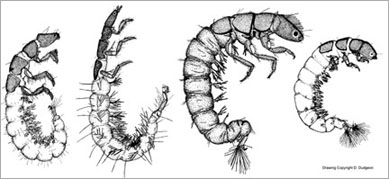 |
The case-making Calamoceratidae and Lepidostomatidae (plus some Leptoceridae)
eat dead leaves while the Rhyacophilidae, Polycentropididae and Ecnomidae
are predators. Some Hydropsychidae supplement their diet by eating insects
accidentally swept into their capture net by the current, while polycentropodids
use their silken net to trap or entangle prey. The Glossosomatidae, Xiphocentronidae,
Psychomyiidae and Helicopsychidae are grazers, although the dependence
upon algae in some families is not well established. Psychomyiidae and
Xiphocentronidae eat considerable quantities of fine organic particles;
the Dipseudopsidae live on this material entirely. The habit of piercing
plant cells (usually filamentous algae) and sucking out their contents
is confined to the Hydroptilidae. Although not exhaustive, this list indicates
the ecological diversity and success of Trichoptera that must, at least
in part, be attributable to the use of silk in net-spinning and case/shelter-building.
Coleoptera
In terms of number of described species, the Coleoptera is the largest
animal order. Although they are diverse in tropical Asian streams, ecological
research on aquatic Coleoptera – or 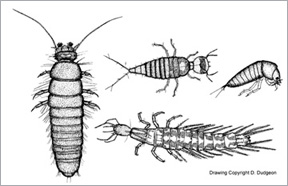 water
beetles – has been hampered by a lack of information on immature
stages, and most larvae cannot be identified to species or even genus.
Some families (e.g., Psephenidae) have terrestrial adults, but the adults
and larvae of the species-rich families (i.e., Elmidae, Dytiscidae and
Hydrophilidae) are aquatic. Elmidae adults and larvae occur together in
the same microhabitat, but this is not always the case for other Coleoptera
so it can be difficult to associate a particular larval type with an adult.
Beetle larvae vary in body form, and although most are elongate with short
legs, Psephenidae are coin-like and flattened. In small rivers, the Coleoptera
fauna is dominated by Elmidae and Psephenidae, with a few representatives
of Eulichadidae and Gyrinidae (adults of which live on the water surface
and are called Whirligig beetles). Hydrophilidae and Scirtidae include
species that live in fast and slow-flowing water, as well as marshy areas,
whereas the Dytiscidae (the most species rich family) occurs mostly in
pools or slow moving water and among aquatic plants. Food habits vary
also: Psephenidae and some Elmidae graze periphyton; Scirtidae eat fine
particles of organic matter; and the Dytiscidae, Gyrinidae and Hydrophilidae
(larvae only) are predators. The Eulichadidae and some Elmidae appear
to feed on dead wood.
water
beetles – has been hampered by a lack of information on immature
stages, and most larvae cannot be identified to species or even genus.
Some families (e.g., Psephenidae) have terrestrial adults, but the adults
and larvae of the species-rich families (i.e., Elmidae, Dytiscidae and
Hydrophilidae) are aquatic. Elmidae adults and larvae occur together in
the same microhabitat, but this is not always the case for other Coleoptera
so it can be difficult to associate a particular larval type with an adult.
Beetle larvae vary in body form, and although most are elongate with short
legs, Psephenidae are coin-like and flattened. In small rivers, the Coleoptera
fauna is dominated by Elmidae and Psephenidae, with a few representatives
of Eulichadidae and Gyrinidae (adults of which live on the water surface
and are called Whirligig beetles). Hydrophilidae and Scirtidae include
species that live in fast and slow-flowing water, as well as marshy areas,
whereas the Dytiscidae (the most species rich family) occurs mostly in
pools or slow moving water and among aquatic plants. Food habits vary
also: Psephenidae and some Elmidae graze periphyton; Scirtidae eat fine
particles of organic matter; and the Dytiscidae, Gyrinidae and Hydrophilidae
(larvae only) are predators. The Eulichadidae and some Elmidae appear
to feed on dead wood.
Diptera
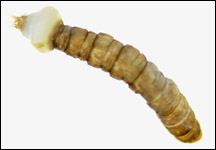 Adult
Diptera are notorious ectoparasites of humans and livestock, and many
transmit disease-causing parasites. Mosquitoes (Anopheles: Culicidae)
carry malaria throughout the tropics and blackflies (Simuliidae) transmit
nematode and protozoan parasites. Apart from the relatively few species
with medical importance, the Diptera (='true' flies) have received scant
attention from river ecologists in Asia. This is despite the fact that
they are one of the most diverse orders of aquatic insects. A common approach
has been to identify the aquatic larvae to the level of family or subfamily
and treat all members of a group as being ecologically equivalent. The
main reason for this state of affairs is that most Diptera larvae have
elongate bodies and all lack segmented legs; they do not possess conspicuous
external gills or other features, and even a head capsule is lacking in
certain groups. This has meant that species identification depends upon
examination of the terrestrial adults, and these are rarely associated
with the aquatic larvae.
Adult
Diptera are notorious ectoparasites of humans and livestock, and many
transmit disease-causing parasites. Mosquitoes (Anopheles: Culicidae)
carry malaria throughout the tropics and blackflies (Simuliidae) transmit
nematode and protozoan parasites. Apart from the relatively few species
with medical importance, the Diptera (='true' flies) have received scant
attention from river ecologists in Asia. This is despite the fact that
they are one of the most diverse orders of aquatic insects. A common approach
has been to identify the aquatic larvae to the level of family or subfamily
and treat all members of a group as being ecologically equivalent. The
main reason for this state of affairs is that most Diptera larvae have
elongate bodies and all lack segmented legs; they do not possess conspicuous
external gills or other features, and even a head capsule is lacking in
certain groups. This has meant that species identification depends upon
examination of the terrestrial adults, and these are rarely associated
with the aquatic larvae.
There are two dipteran suborders: Nematocera and Brachycera. Larvae of
the latter lack a head capsule and the body is often pale and maggot-like.
We know little about the ecology Brachycera in Asian rivers, but they
are not abundant in most habitats. The Nematocera are, by far, the most
diverse aquatic Diptera and, within this suborder, the Chironomidae (or
non-biting midges) numbering at least 20,000 species are arguably the
richest and most abundant family of stream macroinvertebrates. Chironomids
occur in all freshwater habitats, especially where there is some water
movement, but they are tolerant of a wide array of conditions, including
low oxygen and organic pollution. Because most species are small (<10
mm long), their abundance is often underestimated in ecological studies.
Some chironomids graze algae, others filter or gather fine organic particles
from their surroundings, or use a combination of these feeding modes;
some even eat wood. One subfamily (the Tanypodinae) feeds on other chironomids,
and the Chironomidae is an important prey item in the diet of almost all
other aquatic insectivores.
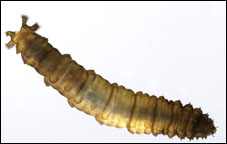 Other
important families of aquatic Nematocera are the Simuliidae, Culicidae,
and to a lesser degree, the Tipulidae. The Blephariceridae are of minor
ecological importance as algal grazers in mountain torrents. Simuliidae
larvae are filter feeders and capture minute particles (mainly smaller
than five microns) from the current using fan-like structures on the head;
they are restricted to fast-flowing water in small stony streams or the
mainstream of larger rivers. The adult females of some Simuliidae (a minority)
require a meal of vertebrate blood before they can lay eggs. Culicid larvae
are generally found in floodplain pools, backwaters, or areas protected
from the current. They filter or gather algae and fine particles of organic
matter with their mouthparts; one genus (Toxorhynchites) is predatory
(often cannibalistic). Adult females of many species are blood feeders.
The Tipulidae includes species that spend their entire life cycle on land
as well as species with aquatic larvae and, for a dipteran, these larvae
can be large (up to 40 mm long). Some tipulids are predators, while others
eat decaying plant material; at least one genus (Antocha) grazes
periphyton.
Other
important families of aquatic Nematocera are the Simuliidae, Culicidae,
and to a lesser degree, the Tipulidae. The Blephariceridae are of minor
ecological importance as algal grazers in mountain torrents. Simuliidae
larvae are filter feeders and capture minute particles (mainly smaller
than five microns) from the current using fan-like structures on the head;
they are restricted to fast-flowing water in small stony streams or the
mainstream of larger rivers. The adult females of some Simuliidae (a minority)
require a meal of vertebrate blood before they can lay eggs. Culicid larvae
are generally found in floodplain pools, backwaters, or areas protected
from the current. They filter or gather algae and fine particles of organic
matter with their mouthparts; one genus (Toxorhynchites) is predatory
(often cannibalistic). Adult females of many species are blood feeders.
The Tipulidae includes species that spend their entire life cycle on land
as well as species with aquatic larvae and, for a dipteran, these larvae
can be large (up to 40 mm long). Some tipulids are predators, while others
eat decaying plant material; at least one genus (Antocha) grazes
periphyton.
Other aquatic insects
Two other aquatic insect orders warrant attention. The order Megaloptera
(i.e., fishflies) is represented mainly by the Corydalidae in Asia. The
aquatic larvae occur in stony rivers, and crawl onto land to metamorphose
into the terrestrial adult. Corydalid larvae are predaceous with well-developed
strong mandibles. The abdomen has a series of lateral filaments, which
may have a respiratory function, and larger species have gill tufts at
the bases of these filaments.
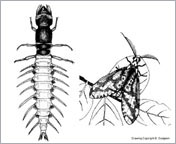 |
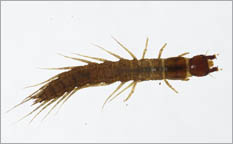 |
The Lepidoptera is a huge order of terrestrial insects that includes
some species with aquatic larvae; all are in the family Pyralidae. They
have a caterpillar-like body shape (sometimes flattened) and are easily
separated from other aquatic insects by the presence of four pairs of
prolegs on the underside of the abdomen; these are used to aid locomotion.
Lepidoptera larvae produce silk: species in fast-flowing rivers live on
top of stones and cover themselves by a protective silk tent. They graze
periphyton. Those that occur in slower flows are usually associated with
aquatic macrophytes, and use silk to make a portable protective case out
of leaf fragments. Herbivorous larvae of terrestrial Lepidoptera may attack
emergent macrophytes, and rice is subject to pest species that bore into
the stems.